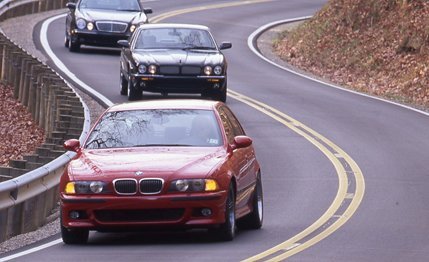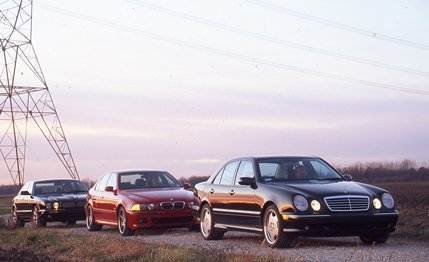 Comparison Tests
Comparison Tests


On the day it went public, your dot.com company's stock was wildly oversubscribed. Despite a complete inability to return profits, its stock is rising on a trajectory steeper than the space shuttle's. Time to stock your adult toy chest before the investors wise up.
You picked up a pricey two-seater after that glorious public offering, but it's not exactly suited to ferrying you and your colleagues to your daily business meetings. Your swollen stock provides the freedom to buy anything on the market, but showing up every day in a Bentley or a Roller gives the wrong impression in the superficially egalitarian circles of the casually dressed West Coast high-tech executive set. Besides, when you're not rearranging electrons to energize Web traffic, you love driving, and you want a sedan that's as exciting and involving as the low-slung sportster with which it will be sharing garage space.
Among the hundreds of models offered by the world's automakers are three that fit these requirements perfectly. They are all powered by gutsy V -8 engines and are fitted with high-performance suspensions, beefy brakes, and sticky steamroller-like tires. And none of them will raise any eyebrows among the unwashed, because they're all variations on models driven by legions of dentists and tax accountants.
The newest of this robust trio is the BMW M5. It's the third 5-series to be enhanced by the ministrations of the company's motorsports department and the first M5 not powered by a descendant of the 24-valve, twin-cam six introduced in the legendary BMW M1 supercar some 20 years ago.
The engine in this new M5, called the S62, is derived from BMW's 4.4-liter corporate V-8, with several important changes. An increased bore and stroke enlarges its displacement from 4398 to 4941cc. A new induction system with dual air cleaners and airflow meters and eight individual throttles feeds the larger engine's appetite for air. BMW's double VANOS system, which can independently vary the timing of the intake and exhaust camshafts over a range of 60 degrees, makes the most of this deep-breathing induction system. An 11.0:1 compression ratio (up from 10.0:1) extracts maximum energy from the trapped charge, while a low-restriction exhaust system with two catalysts and four thick tailpipes reduces the power lost to back pressure. The result is a mighty 400 horsepower at 6600 rpm and 369 pound-feet of torque at 3800 rpm.

Then there's Jaguar's XJR, introduced for 1998. It too is powered by a V-8, but one that uses forced induction to achieve elevated power. By fitting an Eaton-built Roots-type blower that pumps 11.6 psi of boost into the 4.0-liter, four-cam, 32-valve corporate V-8, Jaguar engineers have raised the engine's power from 290 to 370 hp and boosted its torque from 290 to 387 lb-ft. And the peak torque is developed at 3600 rpm, 650 revs lower than in the naturally aspirated engine.
The third Stormer is the Mercedes-Benz E55 AMG. It simply follows the old hot rodder's adage, "There is no substitute for cubic inches." AMG took the Mercedes 5.0-liter V-8, complete with its single overhead camshaft and three valves and two spark plugs per cylinder, and stroked it to displace 5439cc. To feed its bigger cylinders, the AMG engine gets hotter camshafts, a redesigned two-stage intake manifold with larger-diameter runners, and a new, dual-intake air cleaner and matching exhaust system. The result is 349 hp at 5500 rpm. This is the lowest power of this trio, but the AMG V-8 's 391 lb-ft of torque is the highest in the group, and at 3000 rpm, this massive twist comes in earlier than in either of the other cars.
Both the E55 and the XJR route their power through the identical five-speed, electronically controlled automatic gearbox built by Mercedes to handle its 6.0-liter V-12. The transmission programming is different in each application. Jaguar uses its unique but aging J-gate shifter, while Mercedes employs its new "Touch Shift" gate to facilitate manual gearchanges. In contrast, the M5 comes only with a six speed manual transmission, adapted from the 540i sedan.
Otherwise, the cars are very closely matched. They all benefit from beefed-up variations of the sophisticated four-wheel independent suspensions of their host platforms, proctored by electronic stability control systems. They are all shod with grippy 18-inch tires—245/40 front and 275/35 rear Michelin Pilot Sports on the M5 and E55, and 255/40 Pirelli P Zeros on the XJR.

Although the Jaguar, at 197.8 inches long, is about 10 inches longer than its rivals, it isn't roomier, making this dimensional variation functionally irrelevant. All three cars are also lavishly equipped with the most sybaritic conveniences, ranging from a power sunshade in the backlight of the Mercedes to the standard navigation system in the M5 to the umbrella that comes with every XJR. All three cars are even priced on top of one another, with their 70-or-so-grand base prices varying by no more than $3072.
In short, this is a perfectly matched trio of four-door bullets. So well matched that we were forced to spend three glorious days wringing them out over the undulating roads of central Ohio, as well as at that scene of so many Car and Driver near-victories, Nelson Ledges Road Course near Warren.
In the end, we found distinct differences among these three magnificent machines. After most comparison tests, we simply tum our backs to the cars and go on our way. At this one, the keys to these machines had to be pried from our desperately clutching fingers. Among cars that can provide practical transportation on a daily basis, these three are the most satisfying in the world.